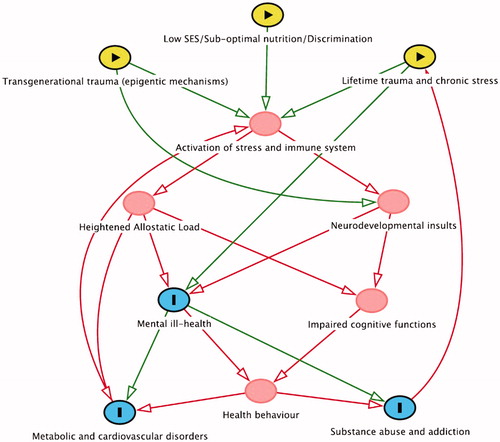Figures & data
Figure 1. Stress and allostatic load in Indigenous health and disease (Image and text reproduced with permission from Sarnyai et al., Citation2016). Transgenerational trauma (e.g. “Stolen Generation”) influences the genome through epigenetic changes, which result in increased susceptibility to future social and environmental stressors and may predispose the individual to diseases in later life. Prenatal and early postnatal stressors, such as poor nutrition, exposure to toxic substances and drugs of abuse, stress associated with low socio- economic status, childhood trauma (neglect and abuse), along with pervasive discrimination create a lifetime exposure to stress and trauma. This will result in a chronically increased activation of the biological stress response and immune system, characterized by elevated cortisol and chronic low-grade inflammation. Ultimately, this leads to increased allostatic load and long-term exposure to these bioactive substances impacts on brain structure (synaptic remodeling, neurogenesis) and function, leading to altered stress perception, emotion regulation, information processing and cognitive function. In a susceptible individual, such changes may contribute to the development of mental health problems, low educational attainment and poor lifestyle choices driven by impaired decision-making processes, which, in turn, lead to alcohol and drug abuse, unhealthy diet and resultant obesity, metabolic syndrome and cardiovascular disorders. Metabolic disturbances in turn contribute to neuroendocrine dysregulations and chronic low-grade inflammation, thus sustaining allostatic load. These, together with self-harm and suicide emerging from the above mental health problems, contribute to early death and the widening of the Indigenous life expectancy gap. Figure 1 and its legend were originally published in: Sarnyai, Berger, & Jawan (Citation2016) Allostatic load mediates the impact of stress and trauma on physical and mental health in Indigenous Australians. Australas Psychiatry 24: 72–75.

Table 1. Studies measuring HPA-axis activity in Indigenous Australians.
Table 2. The 10-parameter allostatic load index (Seeman et al., Citation2001).
